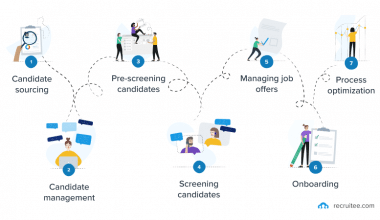In today’s world, receiving, storing, and delivering things effectively is crucial. Most times, store owners and operators encounter issues with supplying affordable products to customers that demand prompt service for their purchases. As such, the struggle to supply and satisfy customers is intensifying. But guess what? You need a top-notch warehouse management system to achieve efficient business operations. So, in this article, we share more on a warehousing management system, covering its various types, best software warehouse systems, project(s), and examples.
What Is A Warehousing Management System?
A warehousing management system (WMS) is a software application that supports the day-to-day operations in a warehouse. A warehousing management system helps warehouse managers control, monitor, and manage the movement and storage of materials in a warehouse. It also helps ensure the right products are available in the right quantities when needed.
A WMS typically includes many features, such as:
- Inventory management.
- Order management.
- Shipping and receiving.
- Picking and packing.
- Stock control.
- Tracking and tracing.
- Reporting.
You can use many types of warehouse management systems, like using the best warehousing software system for your project and other examples.Warehouse managers have long relied on pen and paper, or spreadsheets, to track inventory levels and manage orders. These manual methods are often error-prone and can lead to inefficiencies in warehouse operations. However, with warehousing management system, you can improve accuracy and visibility in warehouse operations, ultimately leading to better customer service and lower operating costs. Additionally, you can integrate WMS with other software applications, such as an enterprise resource planning (ERP) system.
Types Of Warehouse Management Systems
There are four types of warehouse management systems (WMS): standalone WMS, supply chain execution modules, integrated ERP systems, and cloud-based WMS. Each type of system has its strengths and weaknesses, so choose the right one for your needs.
#1. Standalone WMS
A standalone WMS is a software application used to store and manage data related to warehouse operations. Small businesses that operate their warehouses or third-party logistics providers that manage warehouses on behalf of their clients use this type of software. Standalone warehousing management system applications typically include features for tracking inventory levels, managing orders and shipments, and generating reports. There are many benefits to using a standalone WMS.
- Perhaps the most important is that it can help improve the efficiency of warehouse operations. By tracking inventory levels and managing orders and shipments, businesses can ensure that their warehouse staff works on the most important tasks. This can lead to reduced operating costs and improved customer satisfaction.
- Additionally, standalone warehousing management system applications typically offer a high degree of flexibility, which means you can customize them to meet your business’s specific needs.
Hence, standalone WMS can be a good option for businesses that want a complete and independent WMS solution.
#2. Supply Chain Execution Module
A supply chain execution module is among the types of warehouse management systems that help businesses plan, execute and monitor their supply chain operations. This includes order management, warehouse management, transportation management, and more.
An effective supply chain execution module helps enhance the overall performance of the supply chain and even reduces costs. By having a central place to manage all of the supply chain processes, organizations can avoid duplication of effort, and ensure that everyone is working with the most up-to-date information. In addition, a good supply chain execution module provides visibility into the entire supply chain, so you can identify problems and address them quickly.
Meanwhile, the supply chain module is the best choice for third-party logistics (3PL) providers that utilize other warehouse management systems to run their extra business demands.
#3. ERP Module
ERP stands for enterprise resource planning. This warehousing management system helps businesses to manage and store their products more efficiently. The ERP module can be used to manage inventory, finance, manufacturing, and many other business processes.
There are many benefits to using an ERP module:
- First, ERP modules provide real-time inventory information. This means businesses can avoid stock-outs and overages and more accurately predict when to replenish inventory needs.
- Second, ERP modules can automate many tasks associated with managing a warehouse, including order fulfillment, picking, and packing. This can lead to increased efficiency and productivity and free up staff to focus on more strategic tasks.
- And finally, ERP modules can provide visibility into the entire supply chain, from suppliers to customers. This can help businesses to identify bottlenecks and areas for improvement.
Overall, the ERP module or system is very flexible and customizable to fit the needs of any business. Hence, the module is a very powerful tool that can help companies improve their efficiency and bottom line.
#4. Cloud-based WMS
Cloud-based WMS, one of the types of warehouse management systems, is hosted on a remote server. Because of its easy implementation and scalability, cloud-based WMS is usually via “software-as-a-service” (SaaS). In addition to speedier implementation and lower costs, it can offer the same advantages as a more traditional warehousing management system.
Businesses that do not have the resources to host their own WMS use cloud-based. Users can access it from anywhere with an internet connection, especially companies that have multiple locations or a large number of users. Additionally, cloud-based WMS manages inventory and tracks orders and shipments. There are many benefits to using a cloud-based WMS.
- First, it can help businesses save time and money. A cloud-based WMS can automate many tasks such as tracking inventory levels, locations, and stock movements. This can free up time for employees to focus on other tasks, such as picking and packing orders.
- In addition, a cloud-based WMS can help businesses improve their accuracy and visibility. By tracking inventory levels and movements in real-time, businesses can avoid stock-outs and ensure their products are available when and where needed.
If you are considering implementing a cloud-based WMS in your business, first, ensure your warehouse has a reliable internet connection. Second, choose a cloud-based WMS provider that offers a solution that meets your specific business needs. And finally, train your staff on how to use the system.
What Are The 5 Essential Warehouse Management Processes?
There are five essential warehouse management processes: receiving, put-away, inventory management, order picking, and shipping. Each process is necessary for the efficient and effective management of a warehouse.
- Receiving is the process of unloading goods from trucks and checking them against the purchase order to ensure that the correct items were delivered.
- Putaway is the process of storing goods in the warehouse in an organized manner.
- Inventory management is the process of tracking goods as they move in and out of the warehouse.
- Order picking is the process of retrieving goods from the warehouse to fill customer orders.
- Shipping is the process of loading goods onto trucks and sending them to customers.
Which Is Best Software For Warehouse Management?
Are you searching for the best software warehousing management solution to boost effectiveness in your warehouse project? We’ve got you! The best software for a warehousing management system depends on the specific needs of the organization. Some warehouse management system examples worth considering include:
- Blue Yonder Luminate Logistics.
- Extensive 3PL Warehouse Manager.
- Wasp Inventory.
- Advanced Warehouse Management WM1.
- Oracle Warehouse Management Cloud.
- Korber Warehouse Edge.
- IBM Sterling Warehouse Management System.
- Aptean Catalyst WMS, etc.
However, you should consider some factors when making your decision. The factors include the size of your warehouse, the type of products you store, and your budget. These will help you pick the best warehouse software for your warehousing management system or project.
Examples of Warehouse Management System Projects
There are many examples of warehouse management system projects.
- One example of a warehouse management system is a project to develop and track inventory in a warehouse. The system tracks the inventory location, quantity, and status (e.g. whether it is in stock or sold).
- Another example of a warehouse management system project is a system that manages the shipping and receiving of inventory.
From the examples, it means a warehouse management system project might include the installation of a WMS for a retail store, the development of an e-commerce WMS, or the development of a system to manage a manufacturing facility.
Thus, a warehouse management system project can be complex and time-consuming, but it’s typically worth the investment. So, a well-implemented WMS can improve your warehouse productivity, accuracy, and efficiency. It can also help reduce inventory levels and improve customer service.
What Is The Difference Between SAP And WMS?
SAP is a software company that offers enterprise resource planning (ERP) software. It helps businesses manage their entire operation, from financials to inventory to customer relations.
WMS, on the other hand, is a type of software that helps companies manage their warehouse inventory. It focuses solely on warehouse management to help businesses keep track of their inventory, the location, and how much of it they have on hand. It can also help businesses plan their production and shipping schedules, and track their orders.
Both SAP and WMS are important tools for businesses that want to improve their efficiency and bottom line. In essence, SAP provides a comprehensive solution for managing all aspects of a business, while WMS helps businesses specifically with their warehouse management.
Is WMS Considered As ERP?
Enterprise resource planning (ERP) is a software solution that integrates all company necessary processes and functions into a single system. A warehouse management system (WMS) is a software solution that helps companies to manage their warehouse operations. While a WMS is considered a part of an ERP system, it is not considered an ERP system on its own.
Is SAP A Warehouse Management System?
SAP is not a warehouse management system. However, it offers a warehouse management module as part of its broader enterprise resource planning software. You can use the module to track inventory levels, locations, and movements within a warehouse. With the module, you can also manage warehouse staffing and resources, and automate and optimize warehouse operations.
What Is ERP vs WMS?
ERP is enterprise resource planning that tracks and manages information for an entire organization. On the other hand, WMS is a warehouse management system that tracks and manages data for warehouse operations.
What Is An Example Of A Warehouse Management System?
An example of a warehouse management system is the WMS used by Walmart.
Final Thoughts
A warehouse management system (WMS) is a key part of the supply chain and helps companies manage their inventory, track shipments, and optimize their warehouse operations. Many types of WMS software are on the market, and the right system for a company depends on its specific needs and requirements. So, when choosing a WMS, consider the types of products you want to store, the volume of shipments, and the resources available to manage the system.






